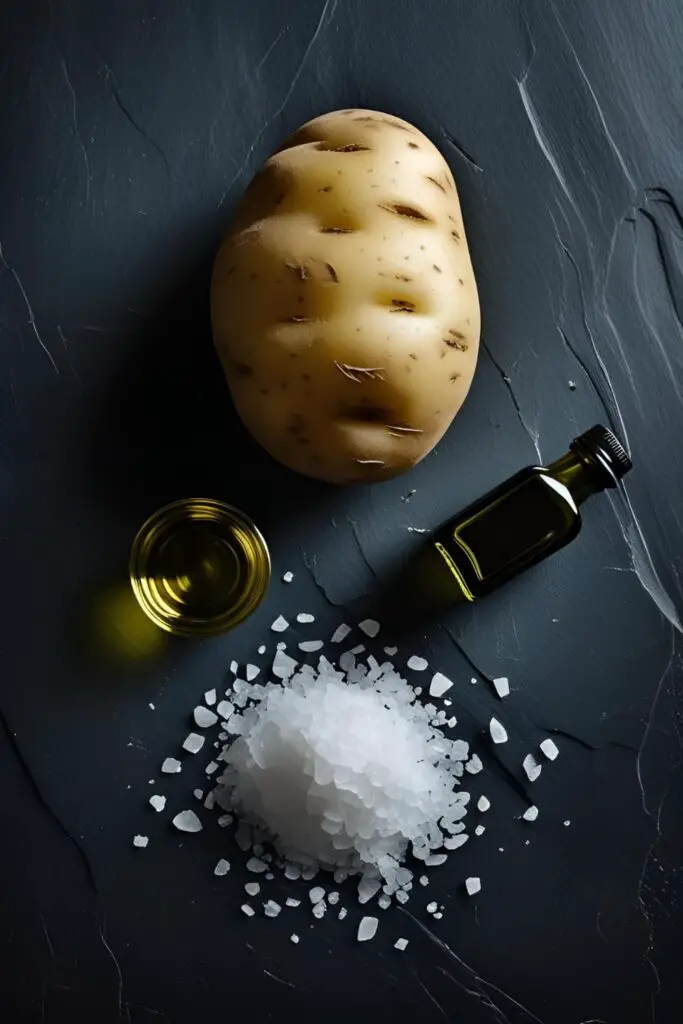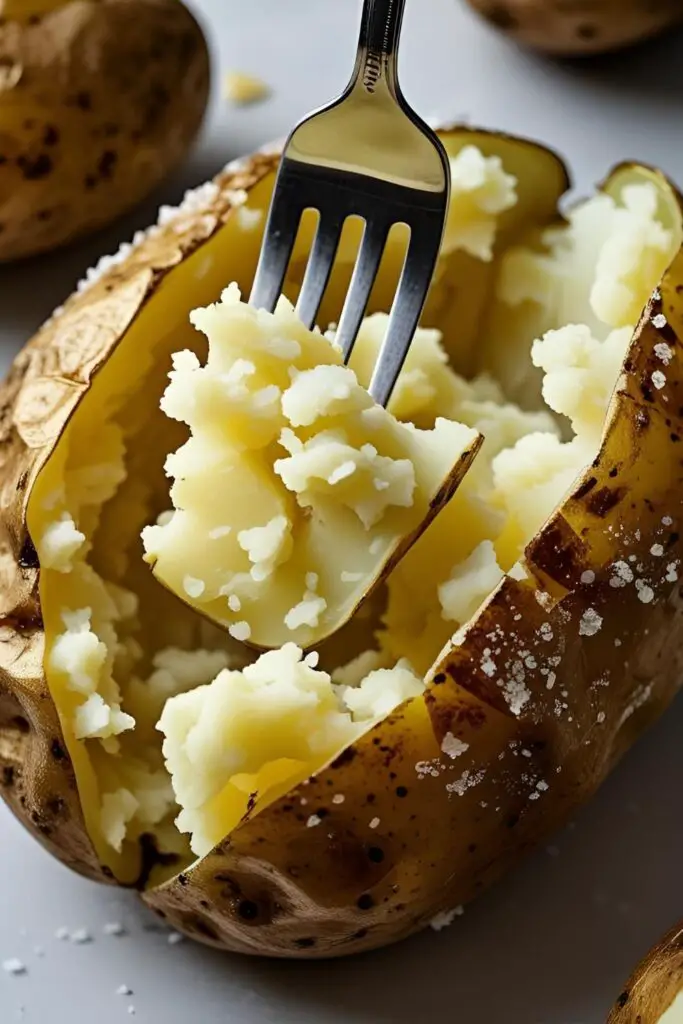You Think You Know How to Make a Baked Potato? Think Again.
Alright, let’s have a little chat. You want to learn how to make a baked potato. “How hard can it be?” you ask, scoffing. “It’s a potato. You put it in the oven.” Oh, you sweet, naive soul. If it were that simple, we wouldn’t live in a world plagued by sad, soggy-skinned, tragically dense baked potatoes.
We’ve all been served one of those foil-wrapped abominations. You know the one—with pale, wet skin and an interior that’s somehow both undercooked and steaming hot. It’s a culinary disappointment. But today, that ends. I’m here to show you the path to baked potato enlightenment, where the skin is salty and shatteringly crisp, and the inside is as light and fluffy as a cloud.
Why This Recipe Is Basically a Life Skill
Why is mastering the baked potato so important? Because it’s the undisputed king of comfort food. It’s a blank canvas for a universe of delicious toppings. It’s the easiest, most satisfying side dish for a steak night and a hearty enough main course to stand on its own.
This isn’t just a recipe; it’s a technique. A technique that transforms a humble, lumpy spud into a culinary event. Once you nail this method, you’ll have a back-pocket trick that will make you look like a kitchen hero with almost zero effort. TBH, it’s the best return on investment in the cooking world.
Ingredients

Don’t blink or you’ll miss it. The beauty is in the simplicity.
- 1 large Russet potato – Yes, it has to be a Russet. They’re starchy and low in moisture, which is the key to fluffiness.
- 1-2 tsp Olive oil or bacon fat – For flavor and crispiness.
- Coarse sea salt or kosher salt – For that salty, crunchy skin. Don’t you dare use regular table salt.
Tools & Kitchen Gadgets
You barely need anything, which is part of the charm.
- Vegetable Brush: To scrub your potato clean.
- A Fork: For poking. It’s very therapeutic.
- Baking Sheet: To catch any drips, though we’re not baking on it.
- Oven Mitts: Because, you know, 400°F ovens are hot.
Step-by-Step Instructions: The Path to Potato Perfection
- Preheat and Prep. Get your oven preheating to 400°F (200°C). While it’s heating up, give your potato a good scrub under running water with a vegetable brush. You want to get all the dirt off because we are eating the skin.
- Dry It Like You Mean It. This is a critical step. Dry the potato completely with a paper towel. I mean, bone dry. Water is the mortal enemy of crispy skin.
- Stab It. Aggressively poke the potato all over with a fork, about 8-10 times. This allows steam to escape while it bakes, preventing a potato explosion in your oven (it happens!) and helping the inside cook evenly.
- Oil It Up. Drizzle the olive oil or smear the bacon fat all over the potato. Use your hands to make sure it’s coated in a thin, even layer. This isn’t just for flavor; it’s what helps the skin get incredibly crispy.
- Make It Rain (Salt). Generously sprinkle the coarse salt all over the oiled potato. More than you think you need. The salt crystals will create a deliciously crunchy crust.
- The Secret Technique. Place the potato directly on the middle oven rack. Do NOT place it on a baking sheet (that steams the bottom skin) and for the love of all that is holy, do NOT wrap it in foil. A baking sheet on a lower rack is fine to catch drips.
- Bake It. Let it bake for 50-60 minutes. You’ll know it’s done when the skin is deep golden brown and crispy, and a fork or skewer inserted into the center meets no resistance.
- The Final Fluff. Using oven mitts, carefully remove the potato from the oven. To get the fluffiest interior, hold the potato in a towel and cut a slit lengthwise down the top, then push the two ends towards the middle to fluff it up. Serve immediately with your favorite toppings.
Calories & Nutritional Info (For one plain potato)
Before you drown it in cheese and bacon, the potato itself is pretty respectable.
- Calories: Approximately 160-200 kcal for a medium-to-large potato.
- Fiber: An excellent source of dietary fiber, especially if you eat the skin.
- Potassium: Contains more potassium than a banana!
- Vitamin C: A good source of this essential vitamin.
Common Mistakes to Avoid
- Wrapping it in Aluminum Foil: This is the number one baked potato crime. Foil traps steam, resulting in a soggy, boiled-tasting potato. You want a baked potato, not a steamed one.
- Using the Wrong Potato: A waxy potato (like a red or new potato) will give you a creamy, dense interior, not a light, fluffy one. Stick with Russets.
- Forgetting to Poke Holes: You’re tempting fate. Poking allows steam to escape, ensuring a fluffy texture and preventing a potato-pocalypse in your oven.
- Baking on a Tray: Placing the potato on a tray creates a flat, soft spot on the bottom. Baking directly on the rack allows hot air to circulate all around it for 360 degrees of crispiness.
Variations & Customizations
A baked potato is a canvas. Go create your masterpiece.
- The Steakhouse Classic: A massive dollop of butter, a spoonful of sour cream, crispy bacon bits, and a sprinkle of fresh chives. It’s a classic for a reason.
- The Chili Cheese Monster: Top it with a hearty scoop of your favorite chili, a mountain of shredded sharp cheddar cheese, and a few pickled jalapeños for a kick.
- The Broccoli Cheddar Dream: Steam some broccoli florets until tender-crisp and smother the potato in a rich, homemade cheddar cheese sauce. It’s like a hug in a potato.
FAQ Section
1. What is the best kind of potato for baking? Russet potatoes are the undisputed champion. Their high starch content and thick skin are perfect for creating a fluffy interior and a crispy exterior.
2. Should I poke holes in my baked potato before baking? Yes, absolutely! Poking holes allows steam to escape, which is crucial for getting a fluffy texture and preventing the potato from bursting in the oven.
3. Is it better to bake a potato in foil or not? Do not use foil if you want crispy skin. Baking directly on the oven rack without foil is the secret to a perfect baked potato. Foil is for steaming, not baking.
4. How can you tell when a baked potato is done? The skin should be dry and crisp. When you gently squeeze it (with an oven mitt!), it should give slightly. The most reliable test is to pierce it with a fork—if it goes in easily with no resistance, it’s ready.
5. Can I make a baked potato in the microwave? You can, but it won’t be the same. A microwaved potato will be cooked, but it won’t have that glorious crispy skin. It’s a shortcut that, IMO, isn’t worth it unless you’re in a massive hurry.
6. How do I get the skin extra crispy? The keys are: dry the potato completely, coat it in oil, salt it generously, and bake it directly on the oven rack. That’s the holy trinity of crispy skin.
7. What temperature should I bake a potato at? 400°F (200°C) is the sweet spot. It’s hot enough to crisp the skin without burning it before the inside is cooked through.
Final Thoughts
There you have it. You are now armed with the knowledge to create a truly superior baked potato. No more excuses for sad, limp spuds. Go forth and bake with confidence! Impress your friends, comfort your soul, and pile on those toppings like nobody’s watching. You’ve earned it.


